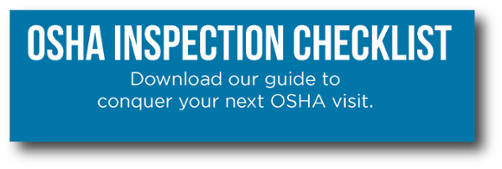An OSHA inspector arrives at your door, unannounced, and wants to conduct an inspection of your workplace. What do you do?
Most companies will choose to let the inspector tour their facilities, talk to whomever they want, and dig into their logs, records, and written programs. You're hit with a citation and owe thousands of dollars in fines.
The thing is, you should be prepared for an OSHA visit before OSHA even shows up at your door.
Why is OSHA visiting me?
OSHA tends to make a visit due to the following circumstances:
- An employee has complained about unsafe operations.
- A fatality or serious injury has occurred at your facility.
- Bad timing! They drive by as one of your employees is doing something they shouldn't be doing.
Preparing for your visit
OSHA doesn't extend the courtesy of letting you know they are on their way, so preparation is key. First things first, you need to designate a company contact to accompany the OSHA co throughout their visit at your facility. Make sure this person is trained and aware of how a typical OSHA visit will play out. Also, they need to know where all necessary information is kept and can easily explain safety policy and procedures. It is also beneficial to have a backup person for this role in case your primary is out of the office.
You should have the following documents available for a potential visit:
- Injury Illness Prevention Program (IIPP)
- Safety manual (Policies and Procedures)
- Hazard assessment and abatement records (Site Inspections)
- Documented training logs
- Equipment inspection records
- Recordkeeping (OSHA 300 logs)
- Review of previous audits and citations
1. Opening Conference
This is where the OSHA inspector introduces themselves, explains why they are there, presents credentials, and explains the inspection procedure. It's a good idea to restrict admittance until the designated company contact is available to handle the OSHA inspection. Receptionists, facility guards, and any other necessary personnel should be briefed on what to do if OSHA arrives.
Also, determine the reason for the inspection. Has an employee complained? Get the details up front.
2. The Inspection
Only show the inspector what you need to. First things first, expose the compliance officer to the least amount of your facility as possible. OSHA can cit any violations they see while at your facility. Directly escort the compliance officer to the designated areas, even if that means walking outside. Never offer a plant tour.
Have mandatory posters hung up. Make sure you have an OSHA poster, hazard communication, lockout/tagout, emergency evacuation, and bloodborn pathogens visible at your site.
Know your rights and make sure your employees do, too. Employees have every right to speak with the compliance officer, but they have every right not to speak with them as well.
Document everything. OSHA inspectors are instructed to take pictures and videos to document any safety violations at your site. You should also follow suite and take pictures of anything they snap. Document everything you can.
Fix small violations immediately. If you have a broken guard rail or something small, fix it immediately. This may prevent you from receiving a citation.
3. The Closing Conference
A closing conference will occur following your inspection - this is required to be done by the OSHA inspector. Use this time to promote your safety programs and show how committed you are to safety and health.
You will not receive any citations at this point in the process. The compliance officer will take the information gathered back to the OSHA office for the area director to review. The area director will assess the information and will issue citations based off the findings.
4. You're cited, now what?
If you are cited, you'll be required to abate all issues that were discovered during the inspection. These deadlines are mandatory and you must document proof of abatement
Next, you have three options that you will need to discuss with your team. All must be completed within 15 working days after you receive your citation:
- Pay the citation(s) that’s given
- Contest the citation(s)
- Request an informal conference with the issuing area director
Which will be the best for you and your team?
When calculating your penalty amount OSHA will factor in all things considered (size of violation, size of your business, past violations). You can also request a meeting with the area director within 15 business days after receiving a citation.
In trucking? Join our webinar targeted towards OSHA in the Transportation Industry.
.png?width=69&height=53&name=Acrisure%20Logo%20(White%20Horizontal).png)


